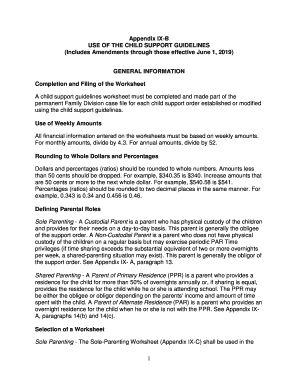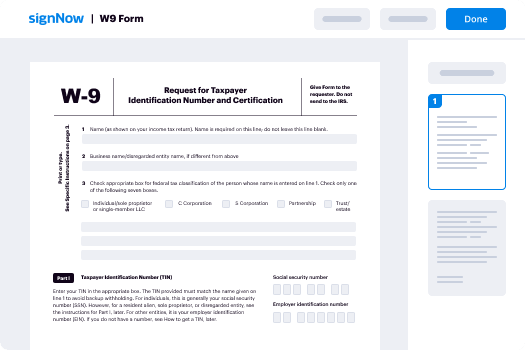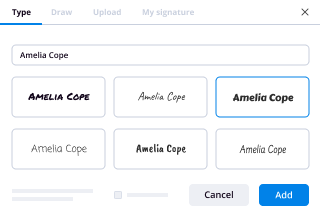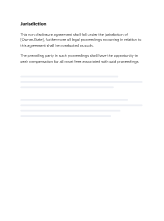1
Appendix IX -B
USE OF THE CHILD SUPPORT GUIDELINES
(Includes Amendments through those effective June 1, 2019 )
GENERAL INFORMATION
Completion and Filing of the Worksheet
A child support guidelines worksheet must be completed and made part of the
permanent Family Division case file for each child support order established or modified
using the child support guidelines.
Use of Weekly Amounts
All financial information entered on the worksheets must be based on weekly amounts.
For monthly amounts, divide by 4. 3. For annual amounts, divide by 52.
Rounding to Whole Dollars and Percentages
Dollars and percentages (ratios) should be rounded to whole numbers. Amounts less
than 50 cents should be dropped. For example, $340.35 is $340. Increase amounts that
are 50 ce nts or more to the next whole dollar. For example, $540.58 is $541.
Percentages (ratios) should be rounded to two decimal places in the same manner. For
example, 0.343 is 0.34 and 0.456 is 0.46.
Defining Parental Roles
Sole Parenting - A Custodial Parent is a parent who has physical custody of the children
and provides for their needs on a day -to -day basis. This parent is generally the obligee
of the support order. A Non -Custodial Parent is a parent who does not have physical
custody of the children on a r egular basis but may exercise periodic PAR Time
privileges (if time sharing exceeds the substantial equivalent of two or more overnights
per week, a shared -parenting situation may exist). This parent is generally the obligor of
the support order. See Appen dix IX - A, paragraph 13.
Shared Parenting - A Parent of Primary Residence (PPR) is a parent who provides a
residence for the child for more than 50% of overnights annually or, if sharing is equal,
provides the residence for the child while he or she is at tending school. The PPR may
be either the obligee or obligor depending on the parents' income and amount of time
spent with the child. A Parent of Alternate Residence (PAR) is a parent who provides an
overnight residence for the child when he or she is not with the PPR. See Appendix IX -
A, paragraphs 14(b) and 14(c).
Selection of a Worksheet
Sole Parenting - The Sole -Parenting Worksheet (Appendix IX -C) shall be used in the
2
following cases: no time sharing (i.e., the child resides with a parent 100% of the t ime),
shared parenting (PAR Time) below the substantial equivalent of two or more
overnights per week (28% of overnights), split parenting (i.e., multiple children; at least
one child residing with each parent), and shared -parenting situations in which an
adjusted award results in the PPR's net household income falling below the PPR
household income reserve set forth in Appendix IX -A, paragraph 14(d).
Shared Parenting - The Shared -Parenting Worksheet (Appendix IX -D) shall be used if
the Parent of Alternate Residence has the child for the substantial equivalent of two or
more overnights per week, excluding extended PAR Time (e.g., vacations) an d has
shown that separate living accommodations for the child are provided in the alternate
household (see shared parenting standards in Appendix IX -A, paragraph 14(c)).
3
LINE INSTRUCTIONS FOR THE SOLE -PARENTING WORKSHEET
Caption
Enter the names of the part ies, the county of venue, the docket number, and the
number of children for whom support is being determined. Check -off whether the
custodial parent is the plaintiff or defendant.
Lines 1 through 5 - Determining Income
Gross Income - For the purpose of these guidelines, gross income is all earned and
unearned income that is recurring or will increase the income available to the recipient
over an extended period of time. When determining whether an income source should
be included in the child support guidelines calculation, the court should consider if it
would have been available to pay expenses related to the child if the family would have
remained intact or would have formed and how long that source would have been
available to pay those expenses.
Sources of Income – Gross income includes, but is not limited to, income from the
following sources:
a. compensation for services, including wages, fees, tips, and commissions;
b. the operation of a business minus ordinary and necessary operating expenses
(see IRS Schedule C);
c. gains derived from dealings in property;
d. interest and dividends (see IRS Schedule B);
e. rents (minus ordinary and necessary expenses - see IRS Schedule E);
f. bonuses and royalties;
g. alimony and separate ma intenance payments received from the current or past
relationships;
h. annuities or an interest in a trust;
i. life insurance and endowment contracts;
j. distributions from government and private retirement plans including Social
Security, Veteran's Administration, Railroad Retirement Board, deferred
compensation, Keoughs and IRA's;
k. personal injury awards or other civil lawsuits;
l. interest in a deceden t's estate or a trust;
m. disability grants or payments (including Social Security disability);
n. profit sharing plans;
o. worker's compensation;
p. unemployment compensation benefits;
q. overtime, part -time and severance pay;
r. net gambling winnings;
s. the sale of investments (net capital gain) or earnings from investments;
t. income tax credits or rebates (excluding the federal and state Earned Income
Credit and the N.J. homestead rebate);
4
u. unreported cash payments (if identifiable);
v. the value of in-kind benefits; and
w. imputed income (see Appendix IX -A, paragraph 12).
Income from self -employment or operation of a business.
a. For income from self -employment, rent, royalties, proprietorship of a business, or
joint ownership of a partnership or cl osely held corporation, gross income is gross
receipts minus ordinary and necessary expenses required for self -employment or
business operation. Personal income from the operation of a business includes all
income sources listed above and potential cash fl ow resulting from loans taken from
the business.
b. Income and expenses from self -employment or the operation of a business should
be carefully reviewed to determine gross income that is available to the parent to
pay a child support obligation. In most c ases, this amount will differ from the
determination of business income for tax purposes.
c. Specifically excluded from ordinary and necessary expenses, for the purposes of
these guidelines, are expenses allowed by the IRS for:
1) the accelerated component of depreciation expenses;
2) first -year bonus depreciation;
3) depreciation on appreciating real estate;
4) investment tax credits;
5) home offices;
6) entertainment;
7) travel in excess of the government rate;
8) non -automobile trav el that exceeds standard rates;
9) automobile expenses;
10) voluntary contributions to pension plans in excess of 7% of gross income; and
11) any other business expenses that the court finds to be inappropriate for
determining gross income for child suppor t purposes.
Sporadic Income
a. If income from any source is sporadic or fluctuates from year -to -year (e.g., seasonal
work, dividends, bonuses, royalties, commissions), the amount of sporadic income
to be included as gross income shall be determined by av eraging the amount of
income over the previous 36 months or from the first occurrence of its receipt
whichever time is less.
b. For overtime pay or income from a second job, the average is based on the prior 12
months or first receipt whichever time is gr eater.
c. The court may exclude sporadic income if the party can prove that it will not be
available in an equivalent amount in the future.
5
Military Pay - All military pay and allowances shall be included as gross income for
determining child support (se e Rose v. Rose , 107 S. Ct . 2029 (1987)).
a. All service members receive Basic Allowance for Quarters (BAQ) and Basic
Allowance for Subsistence (BAS) or live in government accommodations and eat at
mess halls for free. If BAQ and BAS are not received due t o government -provided
accommodations and food, the value of such in -kind income may be included in the
service member's gross income.
b. BAQ, BAS, and Variable Housing Allowances (VHS) are considered income for the
purposes of determining child support. These forms of income are not subject to tax.
In -Kind Income - The fair -market value of goods, services, or benefits received in lieu
of wages and in the course of employment shall be included as gross income if they
reduce personal living expenses of the recipient regardless of whether they are derived
from an employer, self - employment, or the operation of a business. Examples of in -kind
goods, services and benefits include vehicles, automobile insurance, free housing,
meals, benefits selected under a ca feteria plan, memberships, or vacations. Expense
reimbursements are not considered income.
Alimony, Spousal Suppo rt, and/or Separate Maintenance - Alimony, spousal
support, or separate maintenance payments received from a spouse or former spouse
in accord ance wi th a court order are considered income to the recipient. If child support
and alimony, spousal support, or separate maintenance are being determined
simultaneously (for the same family), the court should set the alimony, spousal support,
or separate maintenance first and include that amount in the recipient's income (on Line
1c or Line 4b ) before applying the child support guidelines, except in pendente lite
situations. Alimony, spousal support, or maintenance payments that are being paid to
former s pouses or will be paid in the future (to the spouse in the current action) are
deducted from the payor's income (on Line 1b or Line 4a).
The Tax Cut and Jobs Act of 2017 impacted the tax consequences of alimony, spousal
support, or separate maintenance, resulting in significantly more cases in which alimony
will not be taxable for the recipient or tax -deductible for the payor. There are other
reasons that some alimony may not qualify as taxable and deductible under federal law.
Alimony that is taxable an d deductible will be entered on Lines 1b and 1c. Alimony that
is non -taxable and non -deductible will be entered on Lines 4b and 4c.
Types of Income Excluded from Gross Income - The following types of income are
excluded from gross income :
a. means -tested income (i.e., based on the fact that the recipient has minimal
income and requires government assistance to live) including, but not limited to,
Temporary Assistance to Needy Families (TANF), Deficit Reduction Act
(DEFRA), General Assistance, Refugee Assi stance, rent subsidies, food stamps,
and Supplemental Security Income for the Aged, Blind or Disabled;
b. alimony, spousal support, or separate maintenance payments (the net amount
6
after adjusting for the tax benefits, if any ) to a current or former spouse ;
c. child support received for children of another relationship;
d. non -income producing assets (e.g., undeveloped real estate, automobiles,
jewelry, art, stocks and bonds) unless the court finds that the intent of the
investment was to avoid the payment of child support;
e. income from children, unless the court determines that such income should be
included because the child is a professional or has substantial income that
reduces the family's living expenses;
f. income from other household members (e.g. , step -parents, grandparents, current
spouse) who are not legally responsible for the support of the child for whom
support is being established except to determine the other -dependent credit (the
income of the current spouse may be included if an other -de pendent deduction is
requested - see Appendix IX -A, paragraph 10).
g. for modifications involving retirement income, the pro -rated amount of
contributions to a voluntary plan that were previously included in gross income
when the current support order was established;
h. financial assistance for education including loans, grants, scholarships, veteran's
education benefits, and awards provided under the National and Community
Service Act of 1990 (except post -service benefits); and
i. federal earned income ta x credits.
Collecting and Verifying Income Information
a. Prior to the commencement of a hearing to establish or modify child support, the
parties shall submit either a Case Information Statement (R. 5:5 -2) or a Financial
Statement in Summary Support Act ions (R. 5:5 -3) to the court.
b. When possible, the court should determine gross income as follows:
1) Prior to June 30 of the current year, use Federal and State income tax returns,
W -2 statement(s) and IRS 1099's from the preceding year. If tax documentation
is unavailable, use any other available evidence of current earnings (e.g.,
paystubs, employer wage verifications, or, for the self -employed, statements of
business receipts and expenses). If a joint income tax return includes income of
a per son other than one of the parties involved in the support proceeding (e.g., a
current spouse), the taxpayer or that person's attorney shall be responsible for
the redaction of the tax return.
2) After June 30, use the year -to -date income figure from all do cumented sources
listed above. Divide the total gross income from all sources by the number of
employed weeks to determine the weekly gross income.
3) If no income documentation is available, income may be determined through
testimony or imputed as set for th in Appendix IX -A, para. 10.
Note on Income Documentation: The review of a paystub, W -2 form, IRS -1099 form or
tax return may not provide all necessary income information for a parent. The accurate
determination of income may be dependent on a combinati on of these documents and
7
testimony. Also, note that a parent may have more than one W -2 wage statement if that
person worked for multiple employers during the year.
Taxable and Non -Taxable Income - Before determining Net Income, gross income must
be sepa rated into taxable and non -taxable portions to ensure that withholding taxes are
deducted only from taxable gross income. Generally, the types of income listed below
are not subject to tax. Other types of income may be non -taxable depending on the
status o f the taxpayer or the source of income. For more information on taxable and
non -taxable income, refer to IRS Publication 525 (Taxable and Non -Taxable Income) or,
for New Jersey income taxes, see N.J.S.A. 54A:6 -1 and NJ -WT. The following items are
considere d income to the parents, but should not be used to calculate withholding or
income taxes when determining net income.
1. Income Not Subject to Federal Income Tax
a. Accident and health insurance proceeds;
b. Black -lung benefits;
c. Child support payments ;
d. Federal Employees Compensation Act payments;
e. Interest on state or local obligation;
f. Scholarships and fellowships grants;
g. Veteran's benefits;
h. Worker's compensation;
i. Life insurance proceeds paid due to death of the insured;
j. Social Security benefits. However, if the taxpayer has income of more than
$25,000 if single or $32,000 if married and filing a joint return some of the
benefits may be taxable (see IRS Publication 915);
k. Casualty insurance and other reimbursements; and
l. Earn ings from tax -free government bonds or securities.
2. Income Not Subject to New Jersey State Income Tax
a. Federal Social Security benefits;
b. Railroad Retirement benefits;
c. Proceeds of life insurance contracts payable by reason of death;
d. Employee's death benefits;
e. The value of property acquired by gift, bequest, devise or inheritance except
income from any such property or if the gift, bequest, devise or inheritance is
income;
f. Amounts received under worker's compensation including in come from suits,
agreements, accident or health insurance resulting from personal injuries or
sickness;
g. Compensation paid by the United States for services in the Armed Forces
performed by an individual not domiciled in New Jersey;
h. Grants or scholars hips received from education institutions;
i. Payments of up to $10,000 for a married couple filing jointly, $5,000 for a married
couple filing separately and $7,500 for a single taxpayer from an annuity,
8
endowment or life insurance contract or payments of any such amount received
as pension, disability or retirement benefits for persons at least 62 years old or
disabled under Social Security;
j. New Jersey Lottery winnings;
k. Permanent and total disability benefits under a public or private plan and certa in
accident/health insurance benefits including Veteran's benefits;
l. Unemployment Insurance and Temporary Disability benefits;
m. Interest on obligations issued by the State or any county, municipality, school or
other governmental body of New Jersey and obligations statutorily free from tax
under State or federal law;
n. Amounts contributed by an employer on behalf of an employee to a trust which
meets the requirements of IRC section 401(K) are not taxable in the year when
made;
o. Earnings from tax -free government bonds or securities; and
p. Income Tax Refunds (state or federal).
Note on Social Security Taxes: Social Security tax withholding (FICA) for high -income
persons may vary during the year. In the early part of the year, 6.2% is withheld on the
first $132,900 of gross earnings (for wage earners in 2019). After the maximum $8,240
is withheld, no additional FICA taxes are withheld. Thus, pay stubs issued early in the
year may understate net income, while those issued later in the year may overstate it.
To estimate weekly FICA taxes, amortize the annual FICA tax using the number of
weeks employed or use the Appendix IX -H combined tax tables. Note that self -
employed persons must pay the full FICA tax (12.4%) up to the $132,900 limit of all
earned inco me .
Note on Medicare Taxes: 1.45% of gross earnings is withheld for Medicare taxes. Note
that self -employed persons must pay the full Medicare tax rate (2.9%) on all earned
income. In addition to withholding Medicare tax at 1.45%, a 0.9% Additional Medic are
Tax is withheld from wages in excess of $200,000 in a calendar year. The 0.9%
Additional Medicare Tax also applies to self -employed persons (there is no employer
share of Additional Medicare Tax).
Analyzing Income Tax Returns - For assistance in analyzing income tax returns to
determine parental income, see American Bar Association, Section of Family Law, The
1040 Handbook: A Guide to Income and Asset Discovery, Sixth Edition, 2014.
Government Benefits for the Child - Government benefits for children fall into three
categories. Each is described below along with its treatment in calculating child support.
a. Means -tested benefits - Benefits based on the fact that the child or parent has
minimal income and requires gove rnment assistance. This includes, but is not
limited to, Temporary Assistance to Needy Families (TANF), Deficit Reduction
Act (DEFRA), Refugee Assistance, rent subsidies, food stamps (SNAP), and
Supplemental Security Income for the Aged, Blind or Disabled (SSI), kinship
guardian subsidies. Means -tested benefits for the child are excluded as
9
income (not counted for either parent).
b. Derivative benefits - Benefits based on the contribution (e.g., work history,
military service, disability, or retirement) of one of the parties is an essential
factor in the child's eligibility for the benefit, without regard to family income.
This includes but is not limited to Social Security Disability, Social Security
Retirement, Black Lung, and Veteran's Administration ben efits. The derivative
benefit is counted as income (on Line 5) for the parent whose contribution is
the source of the benefit. If the benefit is based upon contribution of the Non -
Custodial Parent, he or she will also receive a credit for the benefit (on Line
15).
c. Other benefits - Benefits that are obtained without regard to family income or
contribution (e.g., work history, military service, disability, or retirement) of
either party. This includes, but is not limited to, adoption subsidies and Social
Security benefits based on the work history of a non -party relative, such as a
step -parent, grandparent, or deceased parent. This benefit is counted as
income (on Line 5) for the parent who actually receives the financial benefit
(usually the custodial pa rent).
Line 1 - Gross Taxable Income
Enter the weekly gross taxable income of each parent in the appropriate Line 1 column.
Non -taxable income is entered on Line 4.
Line 1a - Mandatory Retirement Contributions
Enter the weekly mandatory retirement cont ributions for each parent in the appropriate
Line 1a column.
Contributions to retirement or pension plans that are mandatory (i.e., required as a
condition of employment) are not considered income for determining child support
obligations. Since mandatory pension contributions are generally non -taxable, the
amount of such payments must be deducted from gross income before withholding
taxes and the Adjusted Gross Taxable Income are calculated. Voluntary payments to
Deferred Compensation Plans (e.g., 401K, 4 14B), Keoughs, and IRA's should not be
deducted from gross income. Calculate the weekly amount of mandatory retirement
contributions by dividing the year -to -date contributions by the number of weeks
employed or by using an average of the prior year's contr ibutions.
Line 1b – Tax -Deductible Alimony Paid
If alimony is tax -deductible for the payor of alimony enter the weekly amount of alimony
or other form of spousal support that is paid or will be paid to a former spouse in the
appropriate Line 1b column.
When established simultaneously with child support (for the same family), the amount of
alimony, spousal support, or separate maintenance should be determined before the
child support guidelines are applied, except in pendente lite situations. Once the amo unt
10
of alimony, spousal support, or separate maintenance is set, it is deducted from the
payor's gross income and added to the recipient parent's gross income for the purposes
of calculating a child support award using the guidelines.
Line 1c – Taxable Al imony Received
If alimony is taxable for the recipient of alimony enter the weekly amount of alimony or
other spousal support that is received or will be received from a former spouse (i.e.,
includes payments from the current as well as any past relationships) in the appropriate
Line 1c column.
For non -tax -deductible alimony paid and non -taxable alimony received, see Line 4a and
Line 4b.
To determine whether a payment from a former spouse is considered alimony or
separate maintenance, see 26 U.S .C. 71.
Line 2 - Adjusted Gross Taxable Income
Subtract mandatory retirement contributions and tax deductible alimony paid from the
gross taxable income and Add any taxable alimon y received to the gross taxable
income to obtain the adjusted gross taxable income. Enter each parent's adjusted gross
taxable income in the appropriate Line 2 column. (Math: Line 1 - Line 1a - Line 1b +
Line 1c )
Line 2a - Withholding Taxes
Enter each parent's combined weekly federal, state, and local withholding taxes in the
appropriate Line 2a column.
Once the taxable portion of gross income is determined, the combined federal, state,
city (if applicable), Social Security, and Medicare withholding taxes are deducted. As set
forth below, four methods are available to determine the amount of combined income
tax withholding to be deducted from gross income.
1. Combined Income Tax Withholding Tables (Appendix IX -H) - To use the combined
tax withholding tables, the gross taxable income and the number of withholding
allowances clai med must be known.
a. Income tax withholding is meant to be consistent with end -of -year tax
obligations to avoid the need for payments or refunds. Generally, individuals
may claim from zero to two withholding allowances for themselves, one for a
spouse, a nd one for each dependent. Starting in the 1998 tax year, additional
allowances may be claimed to accommodate the new child tax credit (see
paragraph b). The number of withholding exemptions claimed may vary with
the taxpayer's marital status, number of jo bs held, estimated adjustments to
income, and the employment status of the taxpayer's spouse (see Section
11
3402 of the Internal Revenue Code, IRS Form W -4, or IRS Pub. 505).
b. Individuals must justify claiming fewer withholding exemptions than allowed
sin ce this may result in less available gross income per payroll period and
may provide the taxpayer with a substantial refund at the end of the year that
will not be considered when determining the child support award. Unless a
party can show good cause for claiming fewer withholding allowances than
permitted, the following standards shall be used to determine withholding
taxes from the Appendix IX -H Combined Tax Withholding Tables:
(1) Two allowances for the parent , and one additional allowance if filing as
head -of -household.
(2) Four allowances for each child if not married and income is less than
$71,201 or if married and income is less than $103,351.
(3) Two allowances for each child if not married and income is between
$71,201 and $179,050, or if married and inco me is between $103,351 and
$345,850.
(4) One allowance for each child if not married and income is between
$179,051 and $200,000, or married and income is between $345,851 and
$400,000.
(To determine eligibility, see IRS Form W -4 and 26 U.S.C.A. § 24).
NOTE: The combined tax withholding table may not result in the correct tax withholding
amount if significant portions of the parent's income are not subject to FICA/Medicare
tax (e.g., alimony, rents, dealings in property, interest income), if wages for federal
income tax and the FICA/Medicare tax differ, or if the parent is self -employed (requires
payment of the full FICA/Medicare tax rate on 92.35% of income - see IRS Pub. 533 or
Schedule SE). Generally, unearned income is not subject to the FICA/Medicare tax.
See the notes at the end of the Appendix IX -H combined tax withholding table.
2. End -of -Year Tax Obligations - If the award is being calculated before June 30 of the
current year and the prior year's federal and state income tax return forms, and Forms
W -2 are available, the tax obligation may be calculated as follows:
a. add the end -of -year income tax obligation (i.e., total tax) from the federal and
state tax return forms, the W -2 Social Security tax withheld, and the W -2
Medicare tax withheld.
b. divi de the sum of the taxes by 52.
3. Year -to -Date Calculation - If the award is being calculated after June 30 of the
current year and a check stub (which represents the parent's only income source) is
available, add the year - to -date federal, state, Social Security and Medicare withholding
taxes and divide the sum by the number of weeks employed.
4. Self -Employed Persons - For persons whose income is derived from self -
12
employment or the operation of a business, the court should carefully review personal
and business income tax returns (State and federal) and IRS -1099 statements from the
most recent tax year to determine the amount of taxes to be deducted from gross
income.
Note: the method of determining withholding taxes and each parent's number of
allowanc es and marital status must be documented in the Comments section (Line 6) of
the worksheet.
Line 2b - Mandatory Union Dues
Enter each parent's weekly mandatory union dues in the appropriate Line 2b column.
Union dues must be mandatory (i.e., required as a condition of employment) to be
eligible as a deduction from a parent's adjusted gross income. Calculate the weekly
amount of mandatory union dues by dividing the year -to -date dues paid by the number
of employed weeks or by using an average of the prior y ear's dues payments.
Line 2c - Child Support Orders for Other Dependents
Enter the weekly amount of court ordered child support of either parent for other legal
dependents in the appropriate Line 2c column.
The child support orders for other dependents are part of an adjustment mechanism to
apportion a parent’s income to all legal dependents including those born before or after
the children for whom support is being determined.
The adjustment requires that three support obligations be considered – (1) th e court
ordered support for the other dependents in the alternate family, (2) a support obligation
that includes the court ordered support for the other dependents, and (3) a support
obligation that does not include the court ordered support for the other dependents.
Line 2 d - Other -Dependent Deduction
Enter the theoretical weekly child support obligation for other legal dependents (from
Line 14 of the Sole -Parenting worksheet prepared for the alternate family) on Line 2d of
the worksheet of the parent re questing the adjustment. The Line 14 amount represents
the parent's income share of the total marginal costs for the children in the alternate
family. The obligation amount for other legal dependents (the other -dependent
deduction) should be calculated on a separate Sole -Parenting Worksheet.
The other -dependent deduction is part of an adjustment mechanism to apportion a
parent's income to all legal dependents including those born before or after the children
for whom support is being determined. Legal depen dents include adopted or natural
children of either parent who are under 18 years of age or over 18 years of age and still
attending high school or other secondary school. No adjustment is provided for
stepchildren. Generally, stepchildren are considered t he legal responsibility of their
13
natural parents unless the court determines that a stepparent has a legal obligation to
support the child.
The adjustment requires that three support obligations be calculated - a theoretical
support obligation for the othe r dependents in the alternate family, a support obligation
that includes the other -dependent deduction, and a support obligation that does not
include the other -dependent deduction. The deduction and the adjusted support
obligation are calculated only if t he income of the other parent in the alternate family is
provided to the court.
1. The amount of the deduction is the serial parent's theoretical support
obligation for the other legal dependents. It requires that a separate Sole -
Parenting child support gu idelines worksheet be completed (through Line 14) for
the children in the alternate family with the serial parent being the theoretical
obligor of those children. The deduction is calculated based on the income of the
parent claiming the deduction and the income of that person's current spouse.
2. A parent must disclose the gross income of the other parent in the
alternate family as a condition to the right to claim this deduction. If the other
parent in the secondary family is voluntarily unemployed or und eremployed, the
court may impute income to that person to determine the parent's obligation to
the children in the secondary family.
3. The amount of the deduction shall not be calculated for alternate families
having more than six children. In such cases, the court may find that the
guidelines are inapplicable and may establish the child support award based on
the factors set forth in N.J.S.A. 2A:34 -23 and existing case law.
Line 3 - Net Taxable Income
Subtract the combined withholding tax, child support orders for other dependents,
mandatory union dues, and the other -dependent deduction*, if any, from the Adjusted
Gross Taxable Income to obtain the Net Taxable Income. (Math: Line 2 - Line 2a - Line
2b - Line 2c - Line 2d). Enter each parent's Net Taxable Income in the appropriate Line
3 column.
*If the other -dependent adjustment is applied , three worksheets must be prepared:
(1) one calculating the parent's obligation for other dependents in the secondary family,
(2) one calculating a support award after d educting the obligation from the parent's net
income, and (3) one calculating the support award as if there were no other dependents
(i.e., the obligation without consideration of other dependents). Thus, financial
obligations for other dependents are not always deducted when figuring net income.
The support award is adjusted for other dependents at the end of the worksheet (Lines
22 through 24).
Line 4 – Non -Taxable Income
Enter each parent's weekly gross non -taxable income in the appropriate Line 4 colum n.
14
Enter the source or type of non -taxable income in the space provided on Line 4 or in the
Comments section of the Worksheet.
Line 4a – Non -Tax -Deductible Alimony Paid
If alimony is non -tax -deductible for the payor, enter the weekly amount of alimony or
other form of spousal support that is paid or will be paid to a former spouse in the
appropriate Line 4a column.
When established simultaneously with child support (for the same family), the amount of
alimony, spousal support, or separate maintenance s hould be determined before the
child support guidelines are applied, except in pendente lite situations. Once the amount
of alimony, spousal support, or separate maintenance is set, it is deducted from the
payor's gross income and added to the recipient pa rent's gross income for the purposes
of calculating a child support award using the guidelines.
Line 4b – Non -Taxable Alimony Received
If alimony is non -taxable for the recipient, enter the weekly amount of alimony or other
spousal support that is receiv ed or will be received from a former spouse (i.e., includes
payments from the current as well as any past relationships) in the appropriate Line 4b
column.
For tax -deductible alimony paid and taxable alimony received, see Line s 1b and 1c.
To determine wh ether a payment from a former spouse is considered alimony or
separate maintenance, see 26 U.S.C. 71.
Line 5 – Government (Non -Means Tested) Benefit for the Child
Government benefits for children fall into three categories. Each is described below
along with its treatment in calculating child support.
a. Means -tested benefits - Benefits based on the fact that the child or parent has
minimal income and requires government assistance. This includes, but is not
limited to, Temporary Assistance to Needy Fami lies (TANF), Deficit Reduction
Act (DEFRA), Refugee Assistance, rent subsidies, food stamps (SNAP), and
Supplemental Security Income for the Aged, Blind or Disabled (SSI), kinship
guardian subsidies. Means -tested benefits for the child are excluded as
inc ome (not counted for either parent). Leave blank Line 5.
b. Derivative benefits - Benefits based on the contribution (e.g., work history,
military service, disability, or retirement) of one of the parties is an essential
factor in the child's eligibility f or the benefit, without regard to family income.
This includes but is not limited to Social Security Disability, Social Security
Retirement, Black Lung, and Veteran's Administration benefits. Enter the
weekly amount of the derivative benefit on Line 5 of the parent whose
contribution is the source of the benefit (i.e., if the Non -Custodial Parent's
15
work history and disability qualify the child for Social Security benefits, the
benefit for the child will be included on Line 5 Non -Custodial Parent). Note, if
the benefit is based upon contribution of the Non - Custodial Parent, he or she
will also receive a credit for the benefit on Line 15.
c. Other benefits - Benefits that are given without regard to family income or
contribution (e.g., work history, military service, disability, or retirement) of
either party. This includes, but is not limited to, adoption subsidies and Social
Security benefits based on the work history of a non -party relative, such as a
step -parent, grandparent, or deceased parent. Enter th e weekly amount of
this benefit on Line 5 of the parent who actually receives the financial benefit
(usually the custodial parent).
Line 6 - Net Income
Add the Net Taxable Income and the Non -Taxable Income to obtain the weekly Net
Income. (Math: Line 3 + Line 4 + Line 5). Enter each parent's Net Income in the
appropriate Line 6 column.
Add the net incomes of the parents to obtain the Combined Net Income (Math: Line 6
Custodial Parent + Line 6 Non -Custodial Parent = Line 6 Combined). Enter the result on
Lin e 6, Combined.
Line 7 - Each Parent's Share of Income
Divide each parent's net income by the combined net income to obtain each parent's
percentage share of income. (Math: Line 6 Custodial Parent ÷ Line 6 Combined =
Custodial Parent Line 7 Share of Income ; Line 6 Non -Custodial Parent ÷ Line 6
Combined = Non - Custodial Parent Line 7 Share of Income). The sum of the two
percentages (ratios) must equal one (the decimal equivalent of 100%). Enter each
parent's income share in the appropriate Line 7 column.
Li ne 8 – Basic Child Support Amount
Look -up the Basic Child Support Amount from Appendix IX -F award schedule. Select
the appropriate amount for the number of children for whom support is being
determined and the Line 6 combined net income of the parents. Ent er the Basic Child
Support Amount on Line 8.
The parents' combined net income and the number of children for whom support is
being determined are used to obtain the basic child support amount from the Appendix
IX -F schedules. Appendix IX -F combined net in comes are provided in $10 increments.
For incomes that fall between income increments, go to the next higher income
increment if the amount is $5.00 or more (e.g., if the combined income is $446, use the
award for $450 combined income; if it is $444, use t he award for $440).
As explained in Appendix IX -A, the basic child support amount represents average
spending on children by intact families (see Appendix IX -A for consumption items
included and excluded in the Appendix IX -F basic child support amount).
16
Line 9 – Adding Net Work -Related Child Care Costs to the Basic Obligation
Calculate net work -related child -care costs using the Appendix IX -E Net Child Care
Expense Worksheet. Enter the weekly net child -care cost (from Line 8 of Appendix IX -E
Worksheet) on Line 9.
Since child care expenses are excluded from the Appendix IX -F child support
schedules, such costs, if incurred by either parent, must be added to the basic support
amount.
1. Qualified Child Care Expenses : Qualified child care expenses are those incurred to
care for a dependent who is under the age of 13 or is physically or mentally
handicapped. These expenses must be necessary for the employment or job search of
the parent. Child care expenses should be r easonable and should not exceed the level
required to provide quality care for the child(ren) from a licensed source. Only the net
cost of child care (after the federal tax credit is deducted) is added to the basic award. It
is assumed that the parent payi ng for child care will apply for and receive the federal
child care tax credit at the end of the tax year.
2. Determining the Net Child Care Cost:
a. Calculate the Adjusted Gross Income (AGI) of the parent paying for child care
by deducting moving expenses, one -half of the self -employment tax, IRA and
Keough contributions, penalties on early withdrawal of savings, self -
employment health insurance cost, and tax deductible alimony paid from that
parent's gross income. If this information is not available, use the parent's
gross income (Line 1 + Line 4).
b. Determine the annual child -care cost.
c. Complete the Net Child Care Expense Worksheet in Appendix IX -E to find the
weekly net child -care cost to be added to the basic support amount.
Line 10 – Adding Health Insurance Costs for the Child to the Basic Obligation
Enter the parent's weekly cost of health insurance for the child for whom support is
being det ermined on Line 10. If the parent's weekly marginal cost is unknown at the
time of the hearing, use the per capita cost of a family policy at the parent's place of
work. Do not include health insurance costs for adults or other dependents.
Since the cost of health insurance for children is excluded from the Appendix IX -F child
support schedules, a parent's contributions to a health insurance policy which includes
the child for whom support is being determined must be added to the basic support
amount. Only the parent's cost of adding the child to the health insurance (medical and
dental) policy is added to the basic support amount (i.e., the marginal premium cost to
the parent to add the child to the policy). If the parent who is providing the health
insura nce has no proof of the cost of adding the child to the health insurance policy, the
parent's total premium cost should be divided by the number of persons covered by the
policy (per capita). The result is then multiplied by the number of children for whom
17
support is being determined to obtain the child's estimated share of the health insurance
cost. For example, if the parent's total health insurance cost is $60 per week and there
are four persons covered by the policy (the parent, the two children who are the
subjects of the support order, and a new spouse), the per capita health insurance cost
for the two children is $30 (($60 ÷ 4 persons = $15) × 2 children = $30). If both parents
provide health insurance for the child, each parent's marginal cost of add ing the child to
the policy should be added together to determine the total health insurance cost for the
child. If the cost of the health insurance policy is unknown at the time of the support
establishment hearing, the parent may apply for a modification of the support order
when such information becomes available.
Line 11 – Adding Predictable and Recurring Unreimbursed Health Care to the
Basic Obligation
Enter the weekly unreimbursed cost of any health care, if predictable and recurring, for
the child t hat exceeds $250 per child per year on Line 11.
Costs under $250 per child per year - Unreimbursed health care expenses (medical and
dental expenses not covered by insurance) up to and including $250 per child per year
are included in the Appendix IX -F ch ild support schedules and are assumed to be paid
by the custodial parent. Because they are part of the basic child support amount, these
ordinary health care expenses are shared in proportion to the relative incomes of the
parents.
Predictable, Recurring Costs above $250 per child per year - Unreimbursed health care
expenses in excess of $250 per child per year are excluded from the child support
schedules. If such expenses are predictable and recurring , they should be added to the
basic support amount usi ng Line 11. The court should consider the duration and
recurring nature of unreimbursed health care expenses prior to adding them to the basic
support amount. If both parents provide predictable, recurring unreimbursed health care
for the child, the cost t o each parent should be added together to determine the total
unreimbursed health care costs. Each parent's direct health care expenses for the child
above the $250 per child annual threshold are credited against his or her share of the
total support award on Line 18.
Unpredictable, Non -Recurring Costs above $250 per child per year - Health -care
expenses for a child that exceed $250 per child per year that are not predictable and
recurring should be shared between the parents in proportion to their relativ e incomes
as incurred. Since these expenses are not included in the support award, the procedure
for sharing such costs should be set forth in the general language of the order or
judgment.
Line 12 - Adding Court -Approved Predictable and Recurring Extraor dinary
Expenses to the Basic Support Amount
Enter court -approved predictable and recurring costs for the child on Line 12.
18
If approved by the court, predictable and recurring extraordinary expenses for the child
that are not included in the Appendix IX -F child support awards may be added to the
basic support amount. Examples of extraordinary expenditures are PAR Time
transportation expenses, special diets, and private education costs for gifted or
handicapped children. See Appendix IX - A, paragraph 8, for a list of items that are
included in the Appendix IX -F awards and an explanation of private education expenses
that may be added to the basic support amount.
Extraordinary expenses for a child that are not predictable and recurring should be
shared betwee n the parents in proportion to their relative incomes as incurred. Since
these expenses are not included in the support award, the procedure for sharing such
costs should be set forth in the general language of the order or judgment.
Each parent's direct spending on court -approved extraordinary expenses for the child
are credited against his or her share of the total support award on Line 19.
Line 13 - Calculating the Total Child Support Amount
Add the basic child support amount, net child -care cost, heal th insurance cost for the
child, predictable and recurring unreimbursed health -care costs above $250 per child
per year, and court -approved predictable and recurring extraordinary expenses. The
result is the Total Child Support Amount. (Math: Line 8 + Line 9 + Line 10 + Line 11+
Line 12). Enter the total support amount on Line 13.
Line 14 - Parental Share of the Total Child Support Obligation
Multiply each parent's percentage share of income by the total child support amount to
find each parent's share of the total child support amount. (Math: Line 7 Custodial
Parent × Line 13 Total Support; Line 7 Non -Custodial Parent × Line 13 Total Support).
Enter each parent's share of the total support amount in the appropriate Line 14 column.
Line 15 - Credit for Der ivative Government Benefits for the Child Based on
Contribution of the Non -Custodial Parent
Enter the weekly amount of the government benefits paid to the custodial parent for the
child (if any) that are based on the contribution (work history, military se rvice, disability,
or retirement) of the non -custodial parent in the Line 15 NCP column.
NOTE: Benefits amount should match the government benefits for the child on Line 5
NCP column.
Line 16 - Credit for Child -Care Payments
Enter payments (if any) for work -related child -care that are being paid by the non -
custodial parent directly to the child care provider in the Line 16 NCP column.
NOTE: Payments cannot exceed the net work -related child care cost on Line 9.
19
Line 17 - Credit for Payment of Child's He alth Insurance Cost
Enter the non -custodial parent's direct payments (or payroll deductions) toward the
marginal cost of adding the child to a health insurance policy in the Line 17 NCP
column. NOTE: Payments cannot exceed the parent's cost of health insur ance for the
child added on Line 10.
Line 18 - Credit for Payment of Child's Predictable and Recurring Unreimbursed
Health Care
Enter the non -custodial parent's direct payments (if any) for predictable and recurring
unreimbursed health care above $250 per child per year in the Line 18 NCP column.
NOTE: Payments cannot exceed predictable and recurring unreimbursed health care
expenses added on Line 11.
Line 19 - Credit for Payment of Court -Approved Extraordinary Expenses
Enter the non -custodial parent's direct payments (if any) for predictable and recurring
extraordinary court -approved expenses in the Line 19 NCP column.
NOTE: Payments cannot exceed predictable and recurring extraordinary court -
approved expenses added on Line 12.
Line 20 - Adjustment fo r Parenting Time Variable Expenses
The court may grant the non -custodial parent an adjustment for parenting time equal to
that parent's income share of the child's variable expenses for the percentage of time
the child is with that parent. When determining if the adjustment is appropriate, the court
should consider whether the non - custodial parent has incurred variable expenses for
the child during the parenting time period and if parenting time reduced the other
parent's variable expenses for the child. I t is assumed that variable costs (food and
transportation) for the child account for 37% of the total marginal child -rearing
expenditures in intact families. The parenting time adjustment should not exceed the
parent's time share of the variable costs for the child.
Complete Lines 20a and 20b before returning to Line 20. Then multiply the basic child
support amount (Line 8) by the non -custodial parent's share of overnights with the child
(NCP Line 20b). Multiply that product by 0.37 (the presumed variable costs). The result
is the maximum NCP parenting time adjustment (the variable cost for the time spent
with the child). Enter the amount on Line 20. (Math: Line 8 x NCP Line 20b x 0.37).
NOTE: If the custodial parent's total household net income (from al l sources) plus the
NCP parenting time -adjusted support award is less than 200% of the poverty guideline
for the number of persons in the household, the NCP parenting time adjustment is not
presumptive and shall be subject to the court's discretion.
20
Line 20a - Number of Overnights with Each Parent
Enter the number of overnights the child has with the custodial parent in the Line 20a
CP column. Enter the number of overnights the child has with the non -custodial parent
in the Line 20a NCP column. Add the t otal number of overnights to Enter in the Line
20a Combined column.
Line 20b - Each Parent's Share of Overnights with the Child
Divide the CP Line 20a by the Combined Line 20a. Enter that number in the Line 20b
CP column. Divide the NCP Line 20a by the Combined Line 20a. Enter that number in
the Line 20b NCP column. The two Line 20a decimals should add up to 1.00.
Line 21 - Net Child Support Obligation
Subtract the non -custodial parent's direct payments for child care, the child's share of
the health i nsurance premium, predictable and recurring unreimbursed health care for
the child above $250 per year per child, and predictable and recurring extraordinary
court -approved expenses from the paying parent's share of the total support amount.
Then, subtract the Line 20 credit, if any, from the non -custodial parent's support
amount and the Line 15 credit, if any, for government benefits for the child based on
contribution of the NCP. The result is the net child support obligation. (Math: (Line 14 -
(Line 15 + Line 16 + Line 17 + Line 18 + Line 19 + Line 20)). Enter the net obligation on
Line 21.
Direct payments and credits are subtracted from the total child support amount to find
the net child support obligation. Direct payments may be deducted only if the c ost was
included in the total child support amount. The net child support obligation for the non -
custodial parent is the support order that will be paid for the benefit of the children.
IF THERE IS NO ADJUSTMENT FOR OTHER DEPENDENTS, GO TO LINE 25
Lines 2 2, 23, and 24 - Adjusting the Child Support Obligation for Other
Dependents
1. If either parent has court ordered child support obligations for other
dependent children or an adjustment for other legal dependents is applicable, the
following amounts must b e considered:
a. The amount of court ordered child support for other dependents (Line
2c) and the other dependent deduction (Line 2d) (where no support order
exists for the dependent) – using the separate other dependent deduction
worksheet;
b. A support obligation for the child for whom support is being determined
calculated after deducting the total of the other dependent orders and
deductions (L2c + L2d); and
21
c. A support obligation for the child for whom support is being determined
calcul ated without deducting the other dependent orders (Line 2c) and
deductions (Line 2d) from the responsible parent's gross income.
2. To ensure that a fair share of the parent's income is available to all his or
her legal dependents, the child support oblig ation for the child for whom support
is being determined will be calculated WITH an income deduction for the court
ordered or theoretical support obligations for other dependents. Then, the
support for the subject child will be calculated WITHOUT consider ation of the
court ordered or theoretical support obligation for other dependents. These two
calculations will be averaged.
Line 22 - Line 21 CS Obligation With Deduction for Other Dependents
Enter the amount of the net child support obligation (Line 21 ) from the worksheet that
deducted the support obligation for the parent's other dependents from the parent's net
income (i.e., with the Line 2c child support order for other dependents and Line 2d other
dependent deduction). Note: the Line 2d other depend ent deduction is calculated on a
separate sole parenting worksheet.
Line 23 - Line 21 CS Obligation Without Deduction for Other Dependents
Enter the amount of the net child support obligation (Line 21) from the worksheet that
did not deduct the support obligation for other dependents (Lines 2c and 2d) from the
parent's net income. Note: The Line 2d other dependent deduction is calculated on a
separate worksheet.
Line 24 - Obligation Adjusted for Other Dependents
Add the Line 22 support obligation that in cludes deductions for other dependents (Line
2c and Line 2d) and the Line 23 support obligation that does not include deductions for
other dependents, then divide the sum by two to obtain the Adjusted Child Support
Obligation for the non -custodial parent. (Math: (Line 22 ) + (Line 23 ) ÷ 2)). Enter the
result on Line 24 .
Lines 25, 26, and 27 - Maintaining a Self -Support Reserve
To ensure that the obligor parent retains sufficient net income to live at a minimum
subsistence level and has the incentive to work , that parent's net child support award is
tested against 105% of the U.S. poverty guideline for one person. If the NCP 's net
income after deducting the child support award is less than the self -support reserve, the
order should be adjusted. No such adjust ment shall occur, however, if the custodial
parent's net income minus the custodial parent's child support obligation is less
than the self -support reserve. This priority is necessary to ensure that custodial parents
can meet their basic needs wh ile caring for the child(ren). The poverty guideline will be
disseminated by the AOC each February or when it is published in the Federal Register.
The self -support reserve test is applied as follows:
22
1. Subtract the obligor's child support obligation from that person's net income.
2. If the difference is greater than 105% of the poverty guideline for one person
($252 per week as of January 11, 2019 ), the self -support reserve is preserved
and the obligor's support obligation is the child support order.
3. If the difference is less than 105% of the poverty guideline for one person and
the custodial parent's net income is greater than 105% of the poverty
guideline, the obligor's child support order is the difference between the
obligor's net income and the 105 % of the poverty guideline for one person.
In determining whether the application of the self -support reserve is appropriate, the
court may need to impute income to a parent as provided in Appendix IX -A. The court
should also consider a parent's actual liv ing expenses and the custodial parent's share
of the support obligation (see Appendix IX -A, paragraph 20).
Line 25 - Self -Support Reserve Test
Calculate whether the obligor's income will exceed 105% of the poverty level by
subtracting the net child support obligation from the non -custodial parent's net income.
(Math: Line 6 NCP - Line 21 or Line 24.) Enter the result for the NCP on Line 25. Enter
the custodial parent's net income minus the custodial parent's child support obligation
(Line 6 minus Li ne 14) on Line 25. Then,
If the NCP Line 25 amount is less than 105% of the poverty guideline and the CP Line 25
minus the CP Line 14 is greater than 105% of the poverty guideline , Go To Line 26.
If the NCP result is greater than 105% of the poverty gui deline, Skip Line 26 and Enter
the Line 21 or Line 24 non -custodial parent child support obligation on Line 27.
NOTE: If the CP Line 25 minus the CP Line 14 amount is less than 105% of the poverty
guideline, there is no NCP self -support reserve adjustment. In this case, the NCP Line
21 or Line 24 amount is the final child support order (Line 27).
Line 26 - Maximum Child Support Order
Subtract the poverty level from the non -custodial parent's net income to find the
maximum child support order. (M ath: Line 6 Non -Custodial Net Income - 105% of the
poverty guideline). Enter the result on Lines 26 and 27.
Line 27 - Child Support Order
Line 27 is the amount to be paid by the non -custodial parent (the obligor) to the
custodial parent (from either Line 25 or Line 26) for the benefit of the children.
23
LINE INSTRUCTIONS FOR THE SHARED -PARENTING WORKSHEET
Caption
Enter the names of the parties, the county of venue, the docket number, and the
number of children for whom support is being determin ed. Check -off whether the Parent
of the Primary Residence is the plaintiff or defendant.
Lines 1 through 5 - Determining Income
Gross Income - For the purpose of these guidelines, gross income is all earned and
unearned income that is recurring or will in crease the income available to the recipient
over an extended period of time. When determining whether an income source should
be included in the child support guidelines calculation, the court should consider if it
would have been available to pay expense s related to the child if the family would have
remained intact or would have formed and how long that source would have been
available to pay those expenses.
Sources of Income - Gross income , includes, but is not limited to, income from the
following sou rces:
a. compensation for services, including wages, fees, tips, and commissions;
b. the operation of a business minus ordinary and necessary operating expenses (see
IRS Schedule C);
c. gains derived from dealings in property;
d. interest and dividends (see IRS Schedule B);
e. rents (minus ordinary and necessary expenses - see IRS Schedule E);
f. bonuses and royalties;
g. alimony and separate maintenance payments received from the current or past
relationships;
h. annuities or an interest in a trust;
i. life insurance and endowment contracts;
j. distributions from government and private retirement plans including Social Security,
Veteran's Administration, Railroad Retirement, deferred compensation, Keoughs and
IRA's;
k. personal injury awards or other civ il lawsuits;
l. interest in a decedent's estate or a trust;
m. disability grants or payments (including Social Security disability);
n. profit sharing plans;
o. worker's compensation;
p. unemployment compensation benefits;
q. overtime, part -time and severa nce pay;
r. net gambling winnings;
s. the sale of investments (net capital gain) or earnings from investments;
t. income tax credits or rebates (excluding the federal and state Earned Income Credit
24
and the N.J. homestead rebate);
u. unreported cash payment s (if identifiable);
v. the value of in -kind benefits; and
w. imputed income (see Appendix IX -A, paragraph 12).
Income from self -employment or operation of a business.
a. For income from self -employment, rent, royalties, proprietorship of a business, or
joint ownership of a partnership or closely held corporation, gross income is gross
receipts minus ordinary and necessary expenses required for self -employment or
business operation. Personal income from the operation of a business includes all
income sour ces listed above and potential cash flow resulting from loans taken from
the business.
b. In general, income and expenses from self -employment or the operation of a
business should be carefully reviewed to determine an appropriate level of gross
income tha t is available to the parent to pay a child support obligation. In most
cases, this amount will differ from the determination of business income for tax
purposes.
c. Specifically excluded from ordinary and necessary expenses, for the purposes of
these guid elines, are expenses allowed by the IRS for:
1) the accelerated component of depreciation expenses;
2) first -year bonus depreciation;
3) depreciation on appreciating real estate;
4) investment tax credits;
5) home offices;
6) entertainment;
7) travel in excess of the government rate;
8) non -automobile travel that exceeds standard rates;
9) automobile expenses;
10) voluntary contributions to pension plans in excess of 7% of gross income; and
11) any other business expenses that the court finds to be inappr opriate for
determining gross income for child support purposes.
Sporadic Income
a. If income from any source is sporadic or fluctuates from year to year (e.g., seasonal
work, dividends, bonuses, royalties, commissions), the amount of sporadic income
to b e included as gross income shall be determined by averaging the amount of
income over the previous 36 months or from the first occurrence of its receipt
whichever time is less.
b. For overtime pay or income from a second job, the average is based on the pr ior 12
months or first receipt whichever time is greater.
c. The court may exclude sporadic income if the party can prove that it will not be
available in an equivalent amount in the future.
Military Pay - All military pay and allowances shall be included as gross income for
25
determining child support (see Rose vs. Rose , 107 S. Ct . 2029 (1987)).
a. All service members receive Basic Allowance for Quarters (BAQ) and Basic
Allowance for Subsistence (BAS) or live in government accommodations and eat at
mess halls for free. If BAQ and BAS are not received due to government -provided
accommodations and food, the value of such in -kind income may be included in the
service member's gross income.
b. BAQ, BAS, and Variable Housing Allowances (VHS) are considered income whe n
determining child support. These forms of income are not subject to tax.
In -Kind Income - The fair -market value of goods, services or benefits received in lieu of
wages and in the course of employment shall be included as gross income if they
reduce per sonal living expenses of the recipient regardless of whether they are derived
from an employer, self - employment, or the operation of a business. Examples of in -kind
goods, services, and benefits include vehicles, automobile insurance, free housing,
meals, benefits selected under a cafeteria plan, memberships, or vacations. Expense
reimbursements are not considered income.
Alimony, Spousal Support, and/or Separate Maintenance - Alimony, spousal
support, or separate maintenance payments received from a spou se or former spouse
in accordance with a court order are considered income to the recipient. If child support
and alimony, spousal support, or separate maintenance are being determined
simultaneously (for the same family), the court should set the alimony, spousal support,
or
















